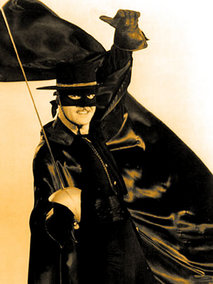
I'm currently reading, on the recommendation of a colleague, Isabel Allende's retelling the of the legend of Zorro. It's an interesting idea. There's a story that's already out there, a cast of characters—Diego De La Vega, Bernardo, Sergeant Garcia, and so on—already in place, all sorts of questions to be accounted for: what made Zorro become Zorro? Why can't Bernardo speak? What did Diego do while he was a young man in Spain? How did he come by his prodigious skills with the sword and the whip? What in the course of his upbringing in a propertied family made him into a defender of the oppressed and downtrodden?
Allende goes after all of these questions with dedication and a sense of humor. She revels in the details. Here, for example, is a description of a street scene in Barcelona on the day that Diego arrives:
Foreigners in assorted attire walked around the docks, insulting one another in incomprehensible tongues: sailors wearing striped stocking caps and sporting parrots on their shoulders, stevedores rheumatic from carrying too-heavy loads, rude vendors selling jerked beef and biscuits, beggars bubbling with lice and pustules, derelicts with ready knives and desperate eyes. Prostitutes of the lowest degree mingled with the crowd, while the more pretentious among them rode in carriages, competing in splendor with privileged ladies. French soldiers trooped around prodding pedestrians with the butts of their muskets for the pure pleasure of annoying them. Behind their backs, women cursed them and spit on the ground. (111)
The passage illustrates what I find myself discussing with my students pretty much every day: the effectiveness of specificity. There's something deeply satisfying to me as a reader when I can be brought down onto the page and then, well, transported in this way. I often tell my students that I want to be able to run a movie in my mind as I'm reading. Their habit is generally to indulge themselves in what I call BUGs, that is, Big Unsupported Generalities. This passage by Allende, a minor passage which is not really advancing the plot at all, shows evidence of a lot of writerly care. There's nothing there which a student would be incapable of thinking of, no single detail which is itself remarkable at the linguistic level. But taken together, the details accumulate into a convincing, visualize-able scene. And because the images and the words and images are concrete, there's a crackle and texture to the language ("prodding pedestrians with the butts of their muskets") which is satisfying at a purely aural level as well.
Ya gotta love it.










No comments:
Post a Comment